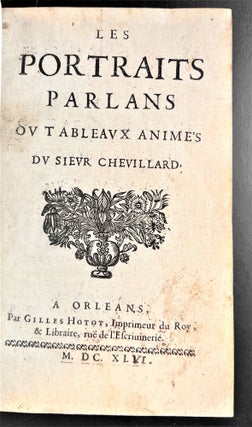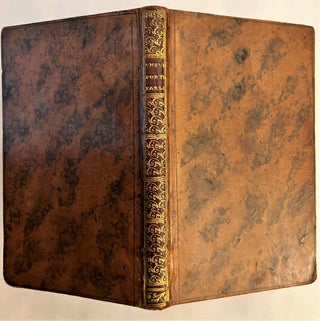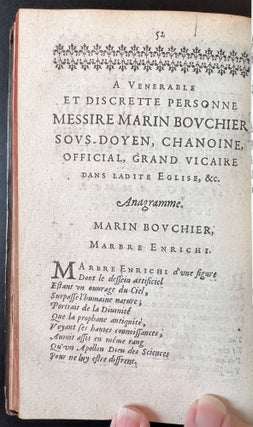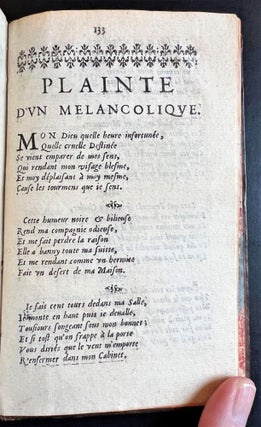Les portraits parlans ou Tableaux animés. Orléans: Gilles Hotot [II], 1641 [i.e., 1646, corrected in ink].
8vo (161 x 96 mm). [40], 136 pp. Woodcut title vignette, tailpieces, and initials, woodcut and typographic headpieces. Printing flaw, p. 123 (2 words covered in the press); slight soiling to title, a few small marginal stains. Contemporary acid-stained calf, smooth spine gold-tooled, edges stained red, marbled endpapers (extremities rubbed).***
First? Edition of a rare collection of anagrammatic, devotional and occasionally macabre poetry. This is one of two editions or issues, both from 1646, of unknown priority. Chevillard was a canon of the church of Sainte-Croix in Orléans and later of the church of Saint-Germain in the same city. His little-known poems range from exceptionally good to outstanding (even Hoefer noted some “sparks of genius”).
As remarked by Hoefer, it was bad luck to be born with the name Chevillard: the poet’s friends couldn’t get enough of anagramming his name, as they demonstrate here in eleven preliminary dedicatory verses, including one on the daring anagram Celuy-là fait Ronsard, by one Lucas. These are followed by 34 pages of Latin religious poems by Chevillard, each in a different meter: a poem to the Virgin in heroic verse, to St. Nicholas in Sapphic verse, to St. Francis in choriambs, etc. Next are a dozen religious poems in French, with varied and original contents, including a poem on the circumcision, on the flight into Egypt, on St. John in the desert, on Jesus obedient to his parents (a reflection on how a carpenter’s son must have felt being the embodiment of the divinity), on the Massacre of the Innocents (a character study of Herod), a lyrical invitation to every part of the universe to praise God (ending with man: “toi composé d’or et de fange / Corps d’animal, esprit d’un Ange, / Ouvrage vil et précieux”...), a panegyric addressed to the Cross, and a slightly jarring Rondeau sur le Crucifix, in 3 quatrains with the capitalized refrain JE VEUX MOURIR.
The last section contains 65 poems, mostly anagrammatic verses on the names of fellow church dignitaries and local notables, some written for specific occasions; these are the “speaking portraits" of the title. The poet’s inventive verve is spirited and varied.
In the final poem he returns to the theme of death. “Plainte d’un melancolique” is an eloquent croak of gloom, in which the poet accurately portrays depression and its manifestations - lack of appetite, disgust with all things human, fascination with cemeteries, etc.
The manuscript correction of the imprint to 1646 appears to be accurate, as Hotot was not yet active in 1641; his father Gilles I Hotot, had died in 1632, and his mother’s name as veuve appeared on their imprints until 1642, when he reached adulthood. USTC and OCLC locate one other copy with the Hotot imprint, at Orléans (pagination not given); two copies with the same pagination but the imprint of the Orléans printer Claude Verjon, at Harvard and Oxford; and two copies with the Verjon imprint, each with a different number of preliminary leaves, and with additional engraved plates (BnF and Orléans).
USTC 6809997; Cioranescu 19187 (no printer given, 1646); Herluison, Recherches sur les imprimeurs & libraires d'Orléans (Orléans, 1868), p. 58, no. 212 (1646); cf. Hoefer, Nouvelle Biographie Générale 10: 272-3. Item #4240
Price: $3,000.00





